🏕 Trees
Important Tree Species
Teak

- Scientific Name: Tectona grandis
- Hindi Name: Teak, Sagwan
- Family:
Verbenaceae - 🤔 Trick to remember is TV (Teak family is Verbenaceae)
- Indigenous in peninsula of India, in North-Eastern drier part of Java and other islands of Indian Archipelago
- The Nilambur in Kerala, manmade teak forest are known to foresters throughout world.
- Teak wood is globally renowned for its strength, durability, dimensional stability, working quality and non-corrosive property when in contact with metal. The durability is attributable to the deposition of polyphenols in its heartwood. On account of these outstanding properties, Teak is sometimes hailed as the
Queen of timbers. - Increasingly large quantities of Teak are used by the
plywood industryIBPS AFO for high grade commercial and tea-chest categories of plywood.
Populus deltoides
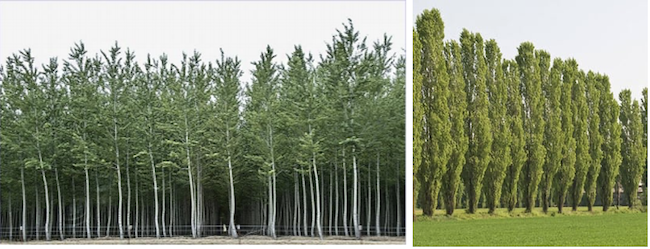
- Family: Salicaceae
- English Name: Poplar
- Native: America (USA)
- Distribution: Tarai region
- Utilisation: Used for paper industry

Eucalyptus

- Scientific Name: Eucalyptus tereticornis
- English Name: Eucalyptus hybrid
- Family: Myrtaceae
- Common Name: Safeda, Nilgiri
- Native to Australia, E. tereticornis was first introduced in the Nandi hills (Karnataka) by Tiuppu Sultan between 1782 - 1790. Grown in Nilgiri region by Britishers.
- Now it is grown over one lakh ha in Peninsular India. Extensive plantations have been raised to meet the needs of fuel wood, small timber and pulpwood in Punjab and Haryana, where area under forest is negligible. It has been planted in strips, 3-6 rows deep along highways, canals and railways. Large scale plantations of the species were taken up in Uttar Pradesh from 1962 onwards.
- Susceptible to termites so less used in furniture.

Bio-drainage plant. Biodrainage is defined as the process of removing the excess soil water through transpiration using bioenergy of the plant and radiation energy of the sun. It is an option to prevent the development of water logging in canal command areas.- Eucalyptus wood is the main stay of paper industry.
- Currently, it is used for making packing cases and 70% of the requirement in Himachal Pradesh for apple transport is met by this species.
- Leaves contain oil.
- Bark yields oxalic acid.
- It is preferred by the farmers by virtue of several desiderata like:
- fast growth
- not browsed by cattle
- immunity to pests and diseases
- good coppicing ability
Tamarind

- Scientific Name: Tamarindus indica
- Hindi name: Imli
- Family: Caesalpinae
- All plant parts find some use, but the most useful is the fruit which contains sweetish acidic pulp. The Tamarind of commerce which is widely used for souring curries, sauces, chutneys and certain beverages.
- The pulp is also employed in medicine. Leaves boiled along with gingelly oil is applied to relieve swelling caused by sprains / fractures and also to relieve pain.
- Pulp mixed with sugar and made into Tamarind balls is used for seasoning other food. Refreshing acid drink and syrup are also made. Leaves serve as good fodder. The tree yields valuable timber, hard and difficult to work.
- The tree is extensively used for avenue planting.
Ailanthus

- Scientific Name: Ailanthus excelsa
- English name: Tree of Heaven
- Hindi name: Arna, Ardu, Maharukh, Arusa
- Family: Simarubiaceae
- A ten year old tree approximately yields 50-75 tonnes of
match wood. The wood is soft, white, very light but fairly strong and easy to saw.

- It is used for match splints, packing cases, fishing catamarans and floats. It is also used for commercial plywood.
- The wood is perishable in the open but not under water. It is grown as shade and avenue tree in hotter parts of India. It yields an inferior type of gum.
- Its bark and gum are of medicinal value. Leaves are highly palatable and nutritious fodder for sheep and goats; and extensively used in Rajasthan.
Neem

- Scientific Name: Azadirachta indica
- English name: Neem, Nim, Indian Lilac, Chinaberry
- Hindi name: Bal-nimb, Neem, Neim, Nimb, Nind
- Family: Meliaceae
- For centuries the neem tree, has provided man with twigs for tooth brushes, pharmaceuticals for aches and pains and pest control agents against insects.
- The drought tolerant neem helps to reduce soil erosion and produces soap, lamp oil, lubricant and lumber. It is also a good shade tree. Every part of neem has its own importance.
- Therefore neem is known as wonder plant.
Prosopis

- Scientific name: Prosopis cineraria
- Hindi Name: Vilayati babool, Vilati khejra
- Family : Mimosae
- It is a versatile multipurpose plant; used as fuel, fodder, and several utility timber and therefore described as “Loyal Timber of the poor”.
- Prosopis cineraria wood is moderately hard and moderately heavy (specific gravity 0.83 to0.88 air dry and 0.78 oven dry). It is excellent for firewood and makes superior charcoal. Because of its high heat value, the wood has been termed “Wooden anthracite”.
Albizzia spp.

- Family: Mimosae
- Albizzia lebbeck (Black Siris) Albizzia procera (Safed sirish).
- Woman’s tongue tree is called Albizia lebbeck.
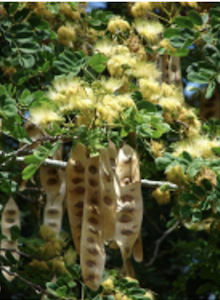
Dalbergia sissoo

- Scientific Name: Dalbergia sissoo
- Common Name: Shisham, Sissu
- Family: Leguminosae
- It is a large deciduous tree with light crown having thick, rough, grey bark with shallow broad longitudinal fissures exfoliating in irregular woody
Acacias
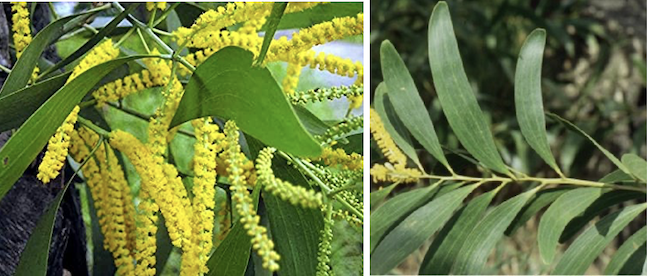
- Scientific Name: Acacia
auriculiformis - English Name: Australian Wattle (Australian origin)
- Family: Mimosae
- It is reasonably good fuel-wood, furniture wood and pulpwood; is suitable as a shade and ornamental avenue tree; useful for afforestation and reclaiming wastelands.

- Scientific Name: Acacia
nilotica - English Name: Indian gum arabic tree
- Hindi Name:
Babul - Family: Mimosae
- Grow in Black cotton soil.
- Leaves and pods are widely used as fodder. It is an extremely valuable source of fuel wood and charcoal of excellent quality. General utility of timbers for construction of carts, wheels, agricultural tools and implements, doors, windows, mine props, fencing materials etc.
- Bark is one of the best tanning materials of North India.
- Babul gum is used in inks, paints, matches and confectionery.
Grewia optiva

- Botanical Name: Grewia optiva
- Common Name: Beul, Dhaman
- Family: Tiliaceae
- It is a very popular tree of the farmers of the sub-Himalayan tract for its fodder, fibres and fuelwood.
Morus alba
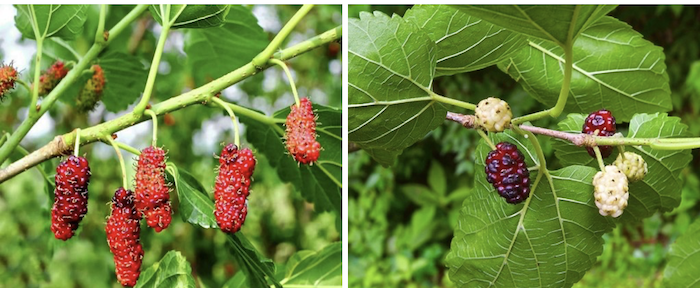
- Botanical Name: Morus alba
- Common Names (Hindi): Shahtut
- Family Name: Moraceae
- Morus alba is cultivated in Northern India from Jammu and Kashmir to Assam. In the Himalayas, it ascends up to an elevation of about 1200 m.
- In the hills, it is mostly confined to stream beds or such other places where sufficient moisture is available for its growth.
- It does not grow on dry slopes or shallow soils where moisture becomes the limiting factor.
Bombax ceiba

- Silk Cotton Tree
- Family:
Malvaceae
Bamboos
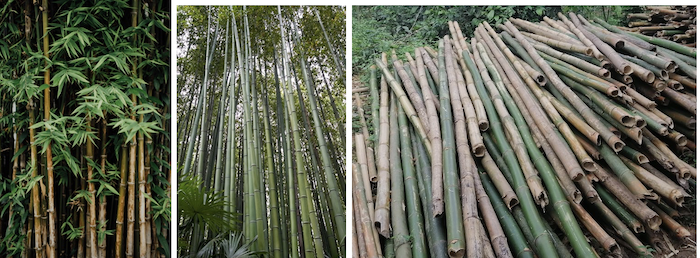
- Scientific Name:
Dendrocalamus strictus - English Name: Solid Bamboo
- Family:
Graminae - Dendrocalamus strictus is the hardest, most widely distributed and important of bamboo species found in India. It occurs throughout the country barring Northern parts of West Bengal, Assam and other very moist areas. It is common in most hilly parts of Peninsular India, except very moist places.
- It occurs in alluvial plains and ravines, and on hill slopes to an altitude of about 1100 m.
- It is mainly used in paper industry.
- Its seeds are eaten by people.
- Leaves and young culms are used as fodder.
Teak

- Scientific Name: Tectona grandis
- Hindi Name: Teak, Sagwan
- Family:
Verbenaceae - 🤔 Trick to remember is TV (Teak family is Verbenaceae)
- Indigenous in peninsula of India, in North-Eastern drier part of Java and other islands of Indian Archipelago
- The Nilambur in Kerala, manmade teak forest are known to foresters throughout world.
- Teak wood is globally renowned for its strength, durability, dimensional stability, working quality and non-corrosive property when in contact with metal. The durability is attributable to the deposition of polyphenols in its heartwood. On account of these outstanding properties, Teak is sometimes hailed as the
Queen of timbers. - Increasingly large quantities of Teak are used by the
plywood industryIBPS AFO for high grade commercial and tea-chest …
Become Successful With AgriDots
Learn the essential skills for getting a seat in the Exam with
🦄 You are a pro member!
Only use this page if purchasing a gift or enterprise account
Plan
Rs
- Unlimited access to PRO courses
- Quizzes with hand-picked meme prizes
- Invite to private Discord chat
- Free Sticker emailed
Lifetime
Rs
1,499
once
- All PRO-tier benefits
- Single payment, lifetime access
- 4,200 bonus xp points
- Next Level
T-shirt shipped worldwide

Yo! You just found a 20% discount using 👉 EASTEREGG

High-quality fitted cotton shirt produced by Next Level Apparel